22.02.2020
LightSail 2 captures stunning photos of Earth from space
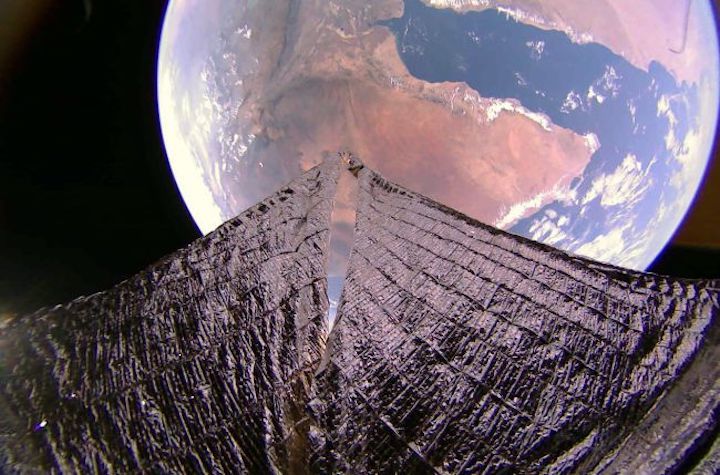
LightSail 2 has been orbiting Earth for eight months now, and it has captured some stunning shots of our home planet during that time.
The Planetary Society built the spacecraft, which launched in June 2019 on a SpaceX Falcon Heavy rocket, to prove the potential of solar sailing. Rather than relying on conventional fuel, LightSail 2 uses a massive sail to catch photons (light particles) from the sun to power the spacecraft's orbit. The goal is for LightSail 2 to remain in orbit for about a year.
Spacecraft personnel have been evaluating LightSail 2's success throughout the mission and recently summarized what they've learned from the flight and how they've handled the anomalies that have occurred.
Based on the flight to date, those personnel have recommended that future solar sails feature solar panels on both sides of the sail, rather than on only one side. That's becauseLightSail 2 uses the one-sided design, and it's caused a few power-production problems for the spacecraft, according to the new report from the team.
The LightSail 2 mission team also recounted the spacecraft's difficulty in navigating Earth's cushy atmosphere, even at altitudes of 450 miles (720 kilometers). Those struggles suggest that solar sail missions will be most successful when targeting even higher altitudes around Earth or venturing into deep space.
But these missions might not be able to take quite as nice photos of Earth.
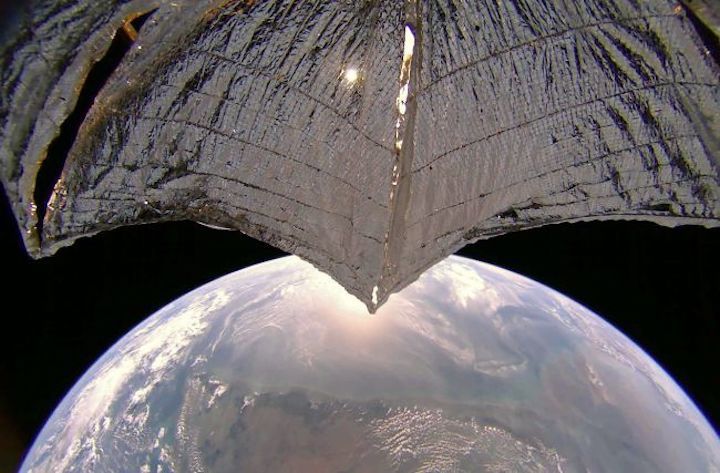




Ten New Pictures from LightSail 2
This month, The Planetary Society's LightSail 2 mission spacecraft celebrates its 10th month in space. The spacecraft continues to successfully operate and use solar sailing for propulsion in low-Earth orbit.
The mission team regularly captures images of LightSail 2's solar sails to see how their condition changes over the course of the mission. Those images often capture stunning vistas of Earth in the process. In honor of our 10th month in space, here are 10 new pictures from orbit.
You can view our entire gallery of LightSail 2 images here. We also have a page where you can see every raw image downlinked from the spacecraft.
SAIL AROUND PLANET EARTH WITH BILL NYE
Sail around Planet Earth with Bill Nye and Dr. Bruce Betts with real space photos taken by the crowdfunded LightSail 2 spacecraft!
LightSail
LightSail is a citizen-funded project from The Planetary Society to send a small spacecraft, propelled solely by sunlight, to Earth orbit.
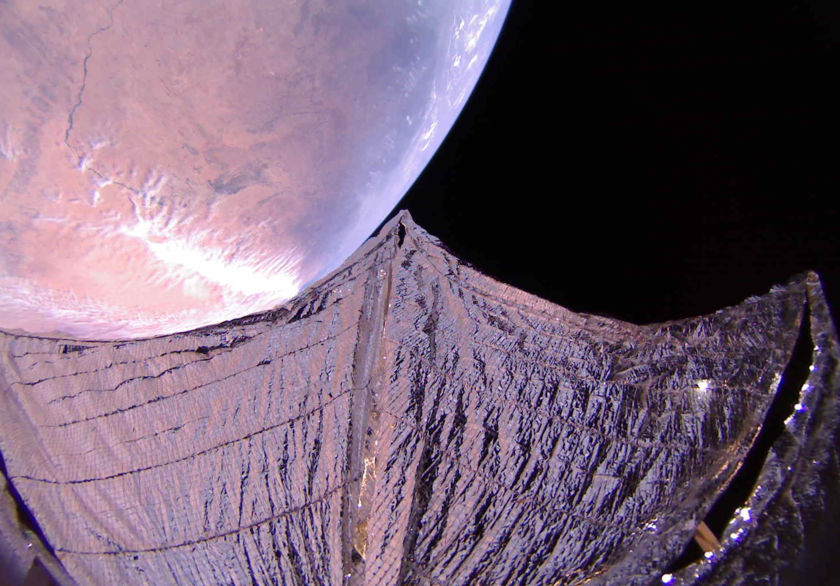
The Planetary Society
WESTERN AFRICA FROM LIGHTSAIL 2
This image taken by LightSail 2 on 8 February 2020 shows western Africa and the Niger River. North is at lower-left. The sail appears slightly curved due to the spacecraft's 185-degree fisheye camera lens. The image has been color adjusted and some of the distortion has been removed.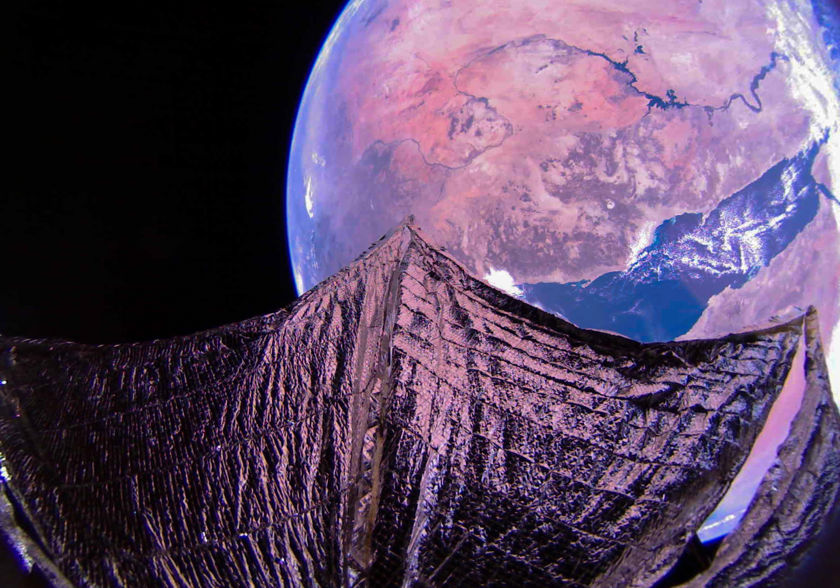
The Planetary Society
THE RED SEA AND NILE RIVER FROM LIGHTSAIL 2
This image taken by LightSail 2's camera 2 on 9 February 2020 shows the Red Sea and the Nile River. North is approximately at right. The sail appears slightly curved due to the spacecraft's 185-degree fisheye camera lens. The image has been color adjusted and some of the distortion has been removed.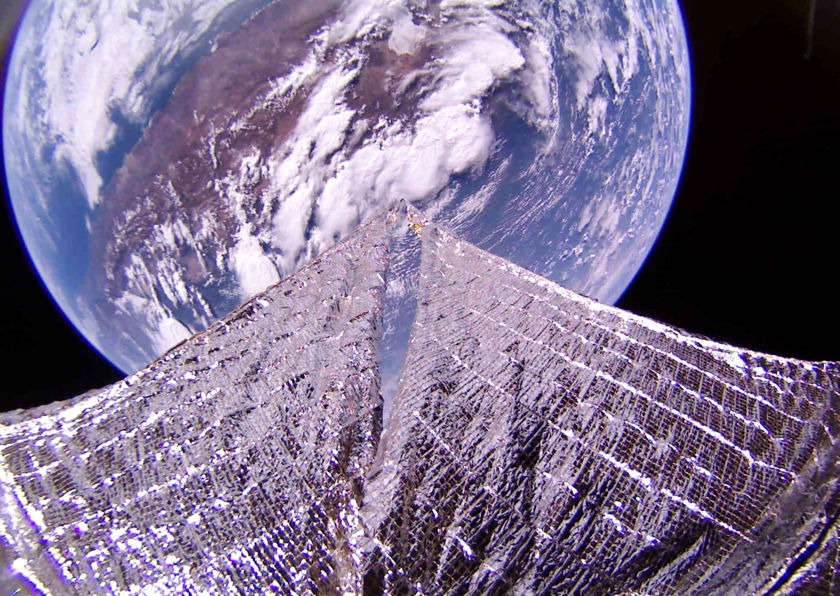
The Planetary Society
CHILE FROM LIGHTSAIL 2
This image of Chile was taken by LightSail 2 on 17 February 2020. The Uyuni Salt Flat in Bolivia can be seen at the top-center. North is at right. The sail appears slightly curved due to the spacecraft's 185-degree fisheye camera lens. The image has been color adjusted and some of the distortion has been removed.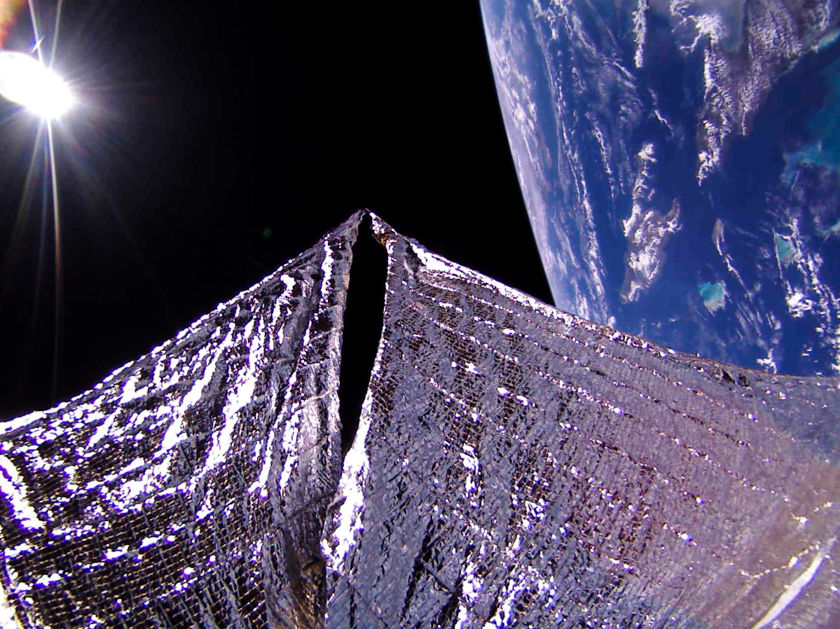
The Planetary Society
LIGHTSAIL 2 SEES CUBA AND THE ISLAND OF HISPANIOLA
This image taken by LightSail 2's camera 1 on 30 January 2020 shows the Caribbean with the east end of Cuba and the island of Hispaniola. North is approximately at right. The sail appears slightly curved due to the spacecraft's 185-degree fisheye camera lens. The image has been color adjusted and some of the distortion has been removed.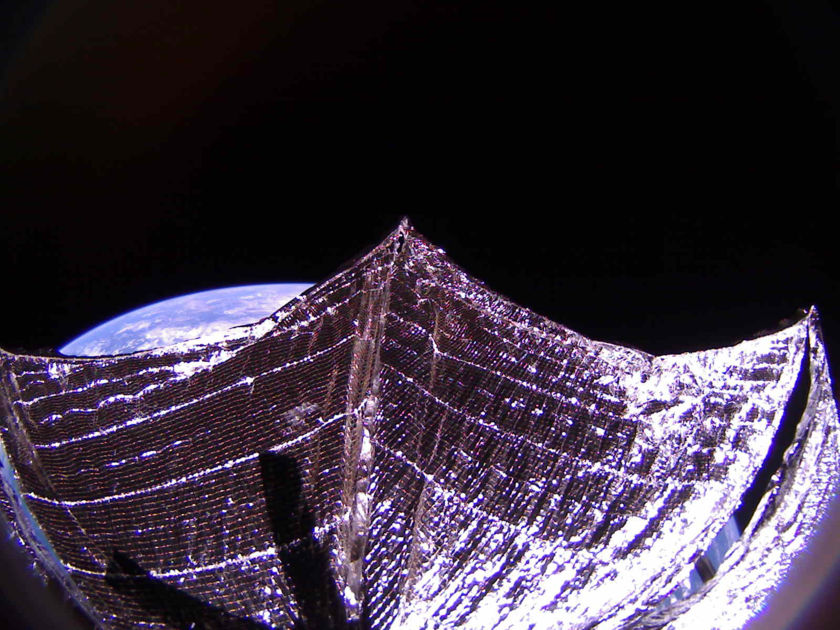
The Planetary Society
SHADOWS FROM LIGHTSAIL 2 SOLAR PANELS ON SAIL
This image taken by LightSail 2 on 13 February 2020 shows shadows from the spacecraft's solar panels on the solar sail. The sail appears slightly curved due to the spacecraft's 185-degree fisheye camera lens. The image has been color adjusted and some of the distortion has been removed.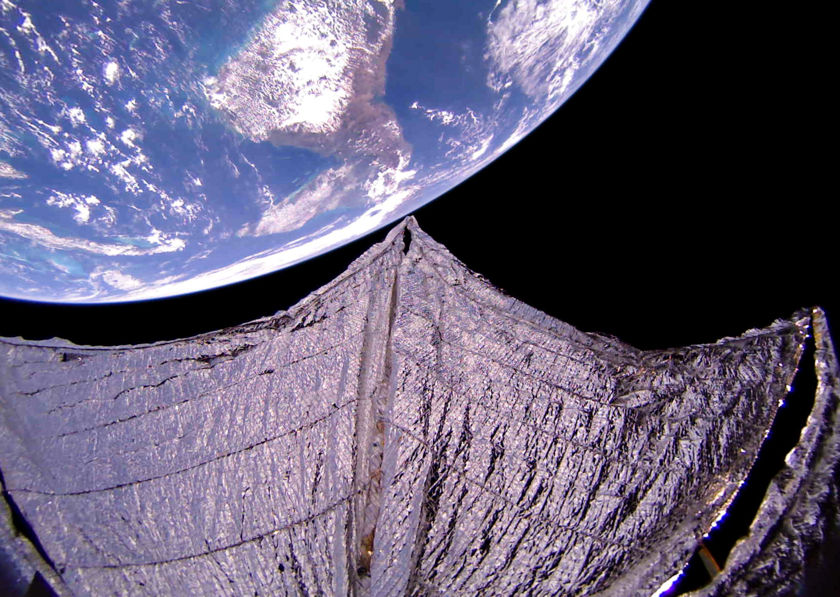
The Planetary Society
CENTRAL AMERICA FROM LIGHTSAIL 2
This image of Central America was taken by LightSail 2 on 13 February 2020. Included in the image are Nicaragua, Central America, and Yucatan. North is at bottom. The sail appears slightly curved due to the spacecraft's 185-degree fisheye camera lens. The image has been color adjusted and some of the distortion has been removed.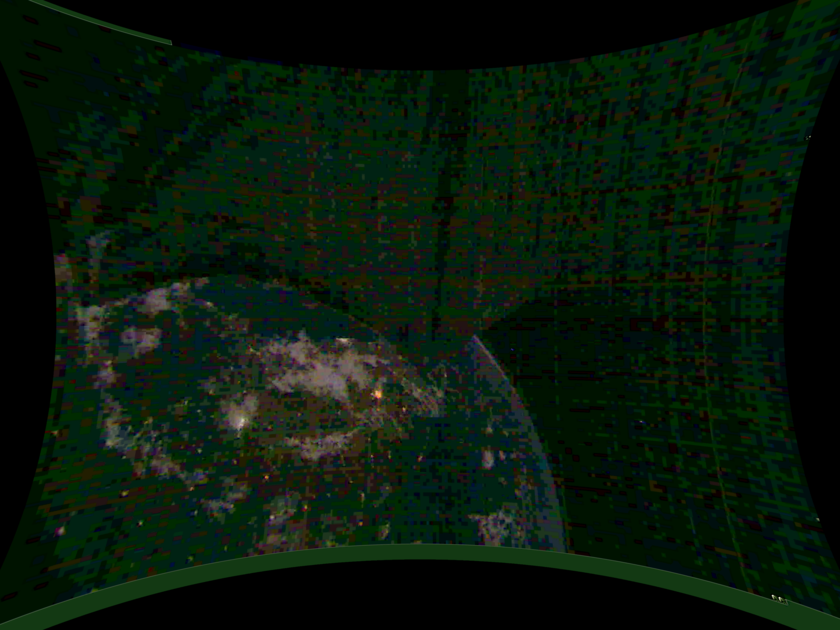
The Planetary Society
INDIA AT NIGHT FROM LIGHTSAIL 2
This image taken by LightSail 2 on 7 March 2020 shows Central India at night. Lights from major cities include Bengaluru, Anantapur, and Chennai. North is at left. The sail, which appears in the foreground, appears slightly curved due to the spacecraft's 185-degree fisheye camera lens. The image has been color adjusted and some of the distortion has been removed.
The Planetary Society
FULL MOON OVER LIGHTSAIL 2
This image taken by LightSail 2 on 7 March 2020 shows a nearly full Moon illuminating part of the solar sail. The sail appears slightly curved due to the spacecraft's 185-degree fisheye camera lens. The image has been color adjusted and some of the distortion has been removed.
The Planetary Society
LIGHTSAIL 2 HIGH-RESOLUTION DEPLOYMENT SEQUENCE, CAMERA 1
These high-resolution images were captured by LightSail 2's camera 1 during sail deployment on 23 July 2019. A fully deployed sail image was added at right. The sail appears slightly curved due to the spacecraft's 185-degree fisheye camera lens; no corrections have been made to the pictures.
The Planetary Society
LIGHTSAIL 2 HIGH-RESOLUTION DEPLOYMENT SEQUENCE, CAMERA 2
These high-resolution images were captured by LightSail 2's camera 2 during sail deployment on 23 July 2019. The sail appears slightly curved due to the spacecraft's 185-degree fisheye camera lens; no corrections have been made to the pictures.LightSail 2 spacecraft ends its solar-sailing mission in a blaze of glory
The crowd-funded craft burned up in Earth's atmosphere on Nov. 17.

The LightSail 2 spacecraft will ride on sunshine no more.
The Planetary Society's crowdfunded solar sailing craft re-entered Earth's atmosphere on Thursday morning (Nov.17) after nearly 3.5 years in orbit — more than three times longer than its designed mission life.
The LightSail 2 team has received no communications from the spacecraft since that date, leading them to conclude that the shoebox-sized craft had finally given up the ghost after completing 18,000 orbits and traveling about 5 million miles (8 million kilometers) around our planet.
"LightSail 2 is gone after more than three glorious years in the sky, blazing a trail of lift with light, and proving that we could defy gravity by tacking a sail in space," science communicator Bill Nye, CEO of The Planetary Society, said in a statement(opens in new tab). "The mission was funded by tens of thousands of Planetary Society members, who want to advance space technology."
LightSail 2 was the first small spacecraft to demonstrate controlled solar sailing, harnessing photons from the sun to adjust its orbit. (LightSail 2 wasn't the first craft of any type to solar sail in space, however; Japan's Ikaros probe did so in 2010.)
While light lacks mass, its individual particles — photons — carry momentum that can be transferred to a reflective surface to give it a tiny amount of push.
LightSail 2 has shown that solar sailing is an effective and viable propulsion method for small spacecraft, including tiny satellites known as cubesats, team members said.
LightSail Program Manager and Chief Scientist Bruce Betts wrote in a Planetary Society statement(opens in new tab) that deorbiting was always going to be LightSail 2's fate, though the fiery end to the mission took longer to manifest than predicted.

The end of LightSail 2 was a drag
LightSail 2 launched in June 2019 aboard a SpaceX Falcon Heavy rocket, tasked with a one-year mission to demonstrated controlled solar sailing in orbit. It began its operations at an altitude of about 450 miles (720 kilometers) above Earth — slightly higher than the orbit of the International Space Station (ISS).
At this altitude, Earth's atmosphere is still dense enough to exert a slight drag on a spacecraft, and it is this effect that eventually sealed the fate of LightSail 2.
Because of the large surface area of the craft's solar sail, which measured 244 square feet (32 square meters) — about the size of a boxing ring — it experienced a larger drag effect than other spacecraft of its mass.
"Imagine throwing a rock compared to throwing a piece of paper. Atmospheric drag will stop the paper much faster than the rock. In our case, LightSail 2 is the paper," Betts wrote. "A spacecraft like the ISS is huge but also massive, more like the rock. But even the ISS has to be boosted higher every few weeks using rockets to compensate for drag."
During its third year of operations, in which it demonstrated its most efficient solar sailing, LightSail 2 experienced increased atmospheric drag due to a boost in solar activity. This activity from the sun heated the atmosphere, making the area LightSail 2 passed through denser.
"That marked the beginning of the end," Betts wrote. "As solar activity increased even more, solar sailing was unable to compete with the increased drag due to atmospheric density increase."

LightSail 2 captured this image of Florida on Dec. 24, 2021. (Image credit: The Planetary Society)
Over the last several weeks, LightSail 2 had been dropping deeper and deeper into Earth's atmosphere, experiencing more and more drag, which, in turn, dramatically increased the rate of its drop.
"The spacecraft was caught in an ever-increasing snowball effect: as the spacecraft got lower, the density increased, which caused the spacecraft to get lower even more quickly," Betts wrote.
While LightSail 2's mission may be over, there is still scientific work to be conducted. The team behind the mission is continuing to analyze data collected by the craft, which remained operational until its final moments.
This data will also be shared with future space missions that also make use of solar sails, such as NASA's NEA Scout, which launched on the agency's Artemis 1mission on Nov. 16 and will hitch a ride on sunlight to travel to the moon and then on to a near-Earth asteroid.
"Despite the sadness at seeing it go, all those who worked on this project and the 50,000 individual donors who completely funded the LightSail program should reflect on this as a moment of pride," Betts wrote.
Quelle: SC

